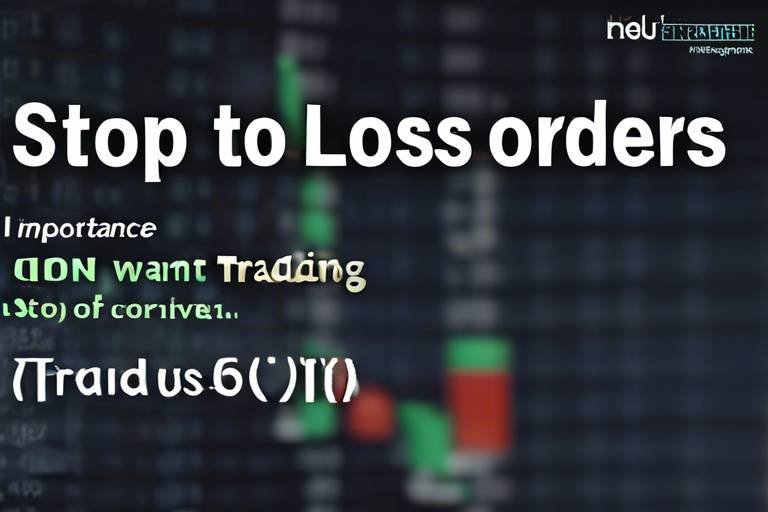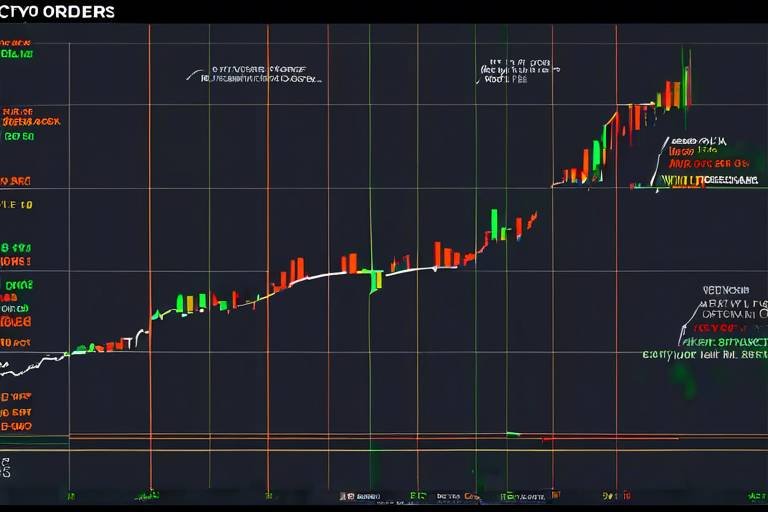How to Use Support and Resistance in Trading
Welcome to the fascinating world of trading! If you've ever dipped your toes into this thrilling arena, you've likely heard the terms support and resistance thrown around like confetti at a celebration. But what do these terms really mean, and why should you care? Well, imagine you're navigating a vast ocean. Support and resistance are like the buoys that guide your ship, helping you avoid rocky shores and turbulent waters. Understanding these concepts is not just beneficial; it’s essential for making informed trading decisions that can significantly impact your success.
At its core, support and resistance are fundamental concepts in technical analysis. These levels represent price points where assets tend to stop and reverse. Think of support as the floor beneath your feet, preventing you from falling too low, while resistance is like a ceiling that keeps pushing you back down when you try to rise. Grasping these concepts is crucial for any trader who wants to navigate the market with confidence and precision.
Recognizing support levels involves digging into historical price movements. It’s like being a detective, analyzing past data to uncover clues about where an asset has previously bounced back. The more you can identify these critical price points, the better equipped you'll be to make informed decisions. So, how do we go about this? Let’s delve into some techniques that can help you spot these vital support levels.
Examining past price charts is a powerful method for pinpointing support levels. This approach involves looking for price points where buying pressure has consistently emerged. Imagine a rubber ball bouncing on the ground; it tends to bounce back up from the same spot repeatedly. Similarly, when an asset hits a support level, it often bounces back, indicating a reliable support zone. By analyzing historical data, traders can identify these zones and use them to their advantage.
Trend lines and moving averages are like your trusty compass, helping you navigate the ever-changing market. They serve as dynamic support levels that can adapt to price changes over time. By drawing trend lines on your charts, you can visualize the direction of the market and identify potential support areas. Moving averages, on the other hand, smooth out price fluctuations, making it easier to spot underlying trends. Combining these tools can enhance your understanding of where support might lie.
Volume analysis adds another layer of depth to your trading strategy. Analyzing trading volume at specific price levels can provide insights into the strength of support. Picture this: if a lot of buyers are stepping in at a certain price point, it indicates strong buying interest, reinforcing that level as a support zone. Conversely, low volume at a support level might signal weakness, suggesting that the support could break. By keeping an eye on volume, you can make more informed decisions about your trades.
Just like support levels, resistance levels are crucial for traders. These are the price points where assets tend to reverse downward. Identifying resistance levels effectively can be the difference between a successful trade and a costly mistake. Similar techniques used for identifying support can be applied here, allowing you to spot these critical price points and incorporate them into your trading strategies.
Now that you understand how to identify support and resistance levels, let’s talk about how to apply this knowledge in your trading strategies. Incorporating these levels into your decision-making process can enhance your overall trading performance. So, how can you leverage support and resistance for entry and exit points?
Support and resistance can serve as your guiding stars when determining optimal entry and exit points. When the price approaches a support level, it might be a signal to enter a trade, anticipating a bounce back. Conversely, if the price nears a resistance level, it could be time to consider exiting your position. By using these levels strategically, you can maximize profits and minimize losses, making your trading journey much more rewarding.
Strategically placing stop-loss and take-profit orders around support and resistance levels can be a game-changer for your trades. It’s like having a safety net that protects you from unexpected falls. By placing your stop-loss just below a support level, you can limit your losses if the trade doesn’t go as planned. Similarly, setting your take-profit near a resistance level can help you lock in gains before the price reverses. This approach to risk management can significantly improve your trading outcomes.
- What is the main difference between support and resistance?
Support refers to price levels where buying interest is strong enough to prevent the price from falling further, while resistance is where selling interest is strong enough to stop the price from rising.
- Can support and resistance levels change?
Yes, support and resistance levels can change based on market conditions, new price movements, and shifts in trader sentiment.
- How can I use support and resistance in my trading strategy?
You can use support and resistance levels to determine entry and exit points, as well as to set stop-loss and take-profit orders for better risk management.

Understanding Support and Resistance
Support and resistance are two of the most crucial concepts in the realm of trading, acting as invisible barriers that dictate price movements. Think of them as the walls of a house; they define the structure and help maintain stability. When traders talk about support, they refer to a price level where an asset tends to stop falling and may even bounce back up. Conversely, resistance is the opposite—it's where the price often stops rising and can reverse downward. Understanding these concepts is not just beneficial; it’s essential for making informed trading decisions.
To truly grasp these concepts, one must realize that support and resistance levels are not static. They can change based on market dynamics and trader sentiment. For instance, if a stock consistently bounces off a particular price point, that level becomes a significant support zone. However, if the price breaks through that level, it can signal a shift in market sentiment, potentially leading to further declines.
In technical analysis, these levels are often represented visually on price charts, where traders can identify historical points of reversal. The key here is to recognize that these levels are not only determined by past price action but also by the collective psychology of market participants. When many traders expect a price to reverse at a certain level, their actions can create a self-fulfilling prophecy.
Moreover, support and resistance can be further categorized into two types: static and dynamic. Static levels are fixed price points based on historical data, while dynamic levels, such as trend lines and moving averages, change as the price evolves. Understanding the difference between these two types can help traders adapt their strategies over time.
To illustrate the significance of these concepts, consider the following table that outlines the key differences and characteristics of support and resistance:
| Aspect | Support | Resistance |
|---|---|---|
| Definition | Price level where buying interest overcomes selling pressure | Price level where selling interest overcomes buying pressure |
| Market Behavior | Tends to bounce back upwards | Tends to reverse downwards |
| Psychological Impact | Signals a buying opportunity | Signals a selling opportunity |
| Breakout Consequences | Breaking support may lead to further declines | Breaking resistance may lead to further gains |
In summary, understanding support and resistance is akin to having a compass in the unpredictable world of trading. It allows traders to navigate the market with greater confidence, making informed decisions based on historical price behavior and market psychology. By mastering these concepts, traders can enhance their ability to predict price movements, ultimately leading to more successful trading strategies.

Identifying Support Levels
Identifying support levels is like being a detective in the world of trading. It requires a keen eye for detail and a solid understanding of price movements. Support levels are those magical zones on a price chart where the buying pressure is strong enough to overcome selling pressure, causing the price to bounce back up. Imagine a trampoline: when you jump on it, you push down, but the elasticity of the material pushes you back up. Similarly, in trading, support levels act as that bounce point for prices.
One effective way to identify these critical price points is through historical price analysis. By examining past price charts, traders can spot where the asset has previously found its footing. Look for instances where the price has dipped down and then swiftly reversed back up. These are often signs of strong support. The more times the price has bounced off a certain level, the stronger that support is likely to be. It's like a favorite spot on a playground that kids keep returning to – it’s familiar and safe.
When diving into historical price analysis, it's essential to look at various time frames. Short-term charts might reveal quick support levels that are useful for day trading, while longer-term charts can highlight more significant support zones that are crucial for swing traders. By viewing the data from different angles, traders can build a comprehensive picture of where support may lie. This method not only helps in identifying support but also in understanding the overall trend of the asset.
Another powerful tool in identifying support levels is the use of trend lines and moving averages. Trend lines are drawn by connecting the lows of price movements over a specific period. When the price approaches this line, it often finds support, much like a safety net. Moving averages, on the other hand, smooth out price data over time and can act as dynamic support levels. For instance, a 50-day moving average can serve as a strong support level during an uptrend. Traders often watch these indicators closely, as they can provide additional confirmation of support.
Volume analysis is another crucial aspect when identifying support levels. The volume of trades at specific price points can indicate the strength of that support. If a price level has high trading volume, it suggests that many traders believe the asset is undervalued at that point, leading to increased buying interest. In contrast, low volume at a support level may indicate a lack of conviction among traders. Thus, combining volume analysis with price levels can significantly enhance the reliability of identified support zones.
In summary, identifying support levels is a multifaceted process that involves analyzing historical price movements, utilizing trend lines and moving averages, and considering trading volume. By honing these skills, traders can make more informed decisions and increase their chances of success in the market.

Historical Price Analysis
When it comes to trading, understanding the past can be your best ally. is like peering through a window into the market's soul. It allows traders to examine how an asset has behaved over time, revealing patterns that can guide future decisions. Think of it as reading a story where each price movement is a chapter that helps you predict the next twist in the tale.
To effectively utilize historical price analysis, traders often look for key price points where the asset has experienced significant reversals. These points are not just random; they are the result of collective market psychology, where buyers and sellers have engaged in a tug-of-war. For instance, if an asset consistently bounces back from a certain price level, that level becomes a critical support zone. Conversely, if the price struggles to break above a particular point, that area is identified as a resistance level.
One effective method for conducting historical price analysis is by examining price charts over various time frames. Traders often use daily, weekly, and even monthly charts to get a comprehensive view. By zooming out, you can spot long-term trends and significant price levels that might not be visible on shorter time frames. This multi-timeframe analysis helps in confirming the strength of identified support and resistance levels.
Additionally, it’s essential to consider the context surrounding these price levels. For example, was there a major news event that caused a price spike? Or perhaps a significant earnings report? Such factors can provide insights into whether a price level will hold in the future or if it’s likely to be breached. Volume analysis also plays a crucial role here; high trading volumes at specific price points often indicate strong buying or selling interest, reinforcing the importance of those levels.
To summarize, historical price analysis is a powerful tool in a trader's arsenal. By understanding where an asset has been, you can make more informed predictions about where it might go next. So, the next time you look at a price chart, remember that you’re not just observing numbers; you’re interpreting a story that can help shape your trading strategy.
- What is the significance of support and resistance in trading?
Support and resistance levels help traders identify potential reversal points in the market, guiding their entry and exit strategies. - How can I identify support and resistance levels?
By analyzing historical price movements, trend lines, moving averages, and volume, traders can pinpoint these critical levels. - Can support and resistance levels change over time?
Yes, as market conditions and trader sentiment shift, previously established support and resistance levels may become less relevant.

Trend Lines and Moving Averages
When it comes to trading, understanding the dynamics of **trend lines** and **moving averages** can be a game changer. These tools not only help traders visualize market trends but also identify potential support and resistance levels. Think of trend lines as the backbone of your trading strategy. They connect significant price points, allowing you to see the overall direction of the market. When you draw a trend line, you're essentially mapping out the path of least resistance. A rising trend line indicates bullish sentiment, while a falling trend line suggests bearish pressure. But how do you draw one? Simply connect at least two significant low points in an uptrend or two high points in a downtrend. The more points you connect, the stronger your trend line becomes.
Now, let’s shift gears to **moving averages**. These are like your trading compass, smoothing out price fluctuations to give you a clearer picture of the market's direction. Moving averages come in various types, but the two most popular are the **simple moving average (SMA)** and the **exponential moving average (EMA)**. The SMA calculates the average price over a specific period, while the EMA gives more weight to recent prices, making it more responsive to new information. Traders often use these averages to identify potential support and resistance levels. For instance, if the price approaches a rising 50-day moving average, it may find support there. Conversely, if the price hits a declining moving average, it could face resistance.
So, how can you effectively use trend lines and moving averages together? One effective strategy is to look for **confluence**, where a trend line and a moving average intersect. This intersection can serve as a strong support or resistance level, providing traders with a higher probability of a successful trade. Imagine you're climbing a mountain; the trend line represents the path you're taking, while the moving average is the weather forecast. If both indicate a favorable condition, you’re more likely to reach your summit successfully.
In summary, incorporating trend lines and moving averages into your trading toolkit can significantly enhance your ability to identify key levels in the market. By understanding how to draw trend lines and calculate moving averages, you can make more informed trading decisions. Remember, the more you practice, the better you'll become at spotting these critical levels, ultimately leading to improved trading outcomes.

Volume Analysis
When it comes to trading, understanding is like having a secret weapon in your arsenal. Volume, in simple terms, refers to the number of shares or contracts traded in a security or market during a given period. But why is this important? Well, volume can provide critical insights into the strength or weakness of a price movement, especially around support and resistance levels.
Imagine you're at a concert, and the crowd's energy surges when the band plays a favorite song. That surge in energy is akin to high trading volume at a support or resistance level. When volume spikes, it indicates that many traders are participating in the market, which can validate the significance of that price level. Conversely, low volume might suggest a lack of interest, making the price movement less reliable.
To effectively analyze volume, traders often look for the following key indicators:
- High Volume at Support: When the price approaches a support level and volume increases, it suggests strong buying interest. This can be a signal that the price is likely to bounce back from that level.
- High Volume at Resistance: Conversely, if the price approaches a resistance level with increasing volume, it indicates strong selling pressure. This might suggest that the price could reverse downwards.
- Volume Divergence: Sometimes, you might notice a divergence between price movement and volume. For example, if the price is making new highs but volume is declining, it could hint at a potential reversal.
Additionally, traders often utilize volume indicators such as the Volume Weighted Average Price (VWAP) and On-Balance Volume (OBV) to further refine their analysis. These tools help in understanding the relationship between price and volume, providing a clearer picture of market sentiment.
In conclusion, incorporating volume analysis into your trading strategy can significantly enhance your ability to make informed decisions. By paying attention to volume trends, especially around critical support and resistance levels, you can better gauge market sentiment and improve your chances of success in trading.
1. What is the significance of volume in trading?
Volume indicates the strength of a price movement; high volume suggests strong interest, while low volume may indicate weakness.
2. How can I identify support and resistance levels using volume?
Look for price levels where significant volume occurs, as this often indicates strong buying or selling interest at those points.
3. Are there specific volume indicators I should use?
Yes, popular indicators include Volume Weighted Average Price (VWAP) and On-Balance Volume (OBV), which help analyze volume trends.
4. Can volume analysis help in risk management?
Absolutely! By understanding volume patterns, traders can better position their stop-loss and take-profit orders around support and resistance levels.

Identifying Resistance Levels
Identifying resistance levels is a critical skill for any trader looking to enhance their trading strategy. Just like a ceiling that prevents a balloon from rising too high, resistance levels are price points where an asset tends to struggle to move upward. These levels often represent a significant selling pressure, where traders might decide to cash out or short the asset. So, how do we pinpoint these elusive resistance levels? Let’s dive into some techniques that can help you become proficient in identifying them.
One of the most effective methods for spotting resistance levels is through historical price analysis. By examining past price charts, traders can identify where the price has previously peaked and subsequently reversed. Look for areas where the price has tested a certain level multiple times without breaking through. These repeated attempts can create a psychological barrier for traders, reinforcing the significance of the resistance level. Remember, the more times a price level has been tested, the stronger that resistance is likely to be.
Another tool in your arsenal is the use of trend lines. Drawing trend lines can help visualize the resistance levels effectively. When you connect the peaks of the price movements with a straight line, you create a trend line that can act as a resistance level. If the price approaches this line and fails to break above it, it reinforces the idea that this level is a strong resistance point. Additionally, you can use moving averages to assist in identifying dynamic resistance levels. For instance, the 50-day or 200-day moving average can often serve as a resistance point, especially in trending markets.
Moreover, volume analysis plays a crucial role in confirming resistance levels. When the price approaches a resistance level with high trading volume, it indicates that many traders are actively participating in the market, often leading to a stronger resistance. Conversely, if the price hits a resistance level with low volume, it might suggest a lack of commitment from traders, making it more likely for the price to break through. Therefore, always consider the volume accompanying price movements when analyzing resistance levels.
To summarize, identifying resistance levels involves a combination of techniques that can provide valuable insights into price behavior. By utilizing historical price analysis, trend lines, moving averages, and volume analysis, you can significantly enhance your ability to recognize these critical price points. Remember, resistance levels are not just numbers on a chart; they represent the collective sentiment of traders in the market. Understanding these levels can help you make more informed trading decisions, ultimately improving your chances of success.

Applying Support and Resistance in Trading Strategies
In the exhilarating world of trading, understanding how to apply support and resistance effectively can be a game changer. These concepts are not just theoretical; they are practical tools that can significantly enhance your trading strategies. By incorporating support and resistance into your trading plan, you can make more informed decisions that may lead to increased profitability. But how exactly can you leverage these levels? Let’s dive into some practical applications!
First off, one of the most crucial aspects of using support and resistance is determining your entry and exit points. Imagine you're a surfer waiting for the perfect wave; you wouldn't just paddle out randomly, right? Similarly, traders need to wait for the right moment to enter or exit a trade. Support levels can act as a safety net, indicating where the price may bounce back up, while resistance levels can signal where to take profits before the price potentially reverses. This strategic approach can help you maximize gains while minimizing losses.
For instance, consider a scenario where a stock has repeatedly bounced off a support level at $50. If the price approaches this level again, it might be a good opportunity to enter a long position, anticipating a bounce. Conversely, if the stock nears a resistance level at $70, it could be wise to consider selling or taking profits, as the price may struggle to break through. In this way, support and resistance levels serve as your trading compass, guiding you toward better decision-making.
Now, let’s talk about stop-loss and take-profit placement. Properly positioning these orders around support and resistance levels can be a critical component of risk management. Placing a stop-loss just below a support level can protect you from unexpected downturns, while setting a take-profit just below a resistance level can help you secure profits before a potential reversal. This strategy not only helps you manage risk but also allows you to trade with greater confidence.
To illustrate this further, consider the following table that outlines a hypothetical trade scenario:
| Trade Action | Price Level | Rationale |
|---|---|---|
| Entry Point | $50 (Support) | Price has bounced off this level multiple times. |
| Stop-Loss | $48 | Just below the support level to minimize losses. |
| Take-Profit | $68 | Just below the resistance level to secure profits. |
By following this structured approach, you can enhance your trading strategy and better navigate the volatile market waters. Remember, the key to successful trading isn’t just about knowing when to buy or sell; it’s about understanding the market psychology that drives price movements. Support and resistance levels provide insight into where traders are likely to enter or exit positions, giving you an edge in predicting future price action.
In conclusion, applying support and resistance in your trading strategies is not just about identifying these levels; it’s about using them to inform your decisions. Whether you're entering or exiting trades, or managing risk with stop-loss and take-profit orders, these concepts can be invaluable. So, the next time you sit down to analyze a chart, remember to look for those critical support and resistance levels—they may just lead you to your next big trading opportunity!
What are support and resistance levels?
Support levels are price points where an asset tends to stop falling and may bounce back up, while resistance levels are where prices tend to stop rising and may reverse downward.
How do I identify support and resistance levels?
You can identify these levels through historical price analysis, trend lines, moving averages, and volume analysis.
Can support and resistance levels change?
Yes, support and resistance levels can change over time as market conditions evolve and new price data becomes available.
How can I use support and resistance in my trading strategy?
You can use these levels to determine optimal entry and exit points, as well as for placing stop-loss and take-profit orders to manage risk effectively.

Entry and Exit Points
When it comes to trading, knowing your can make all the difference between a profitable trade and a costly mistake. Think of it as navigating a ship through treacherous waters; without a clear map, you might find yourself lost or, worse, shipwrecked. Support and resistance levels act as your navigational aids, guiding you toward the best times to enter and exit trades.
So, how do you effectively use these levels to determine your entry and exit points? First, consider the support level. When the price of an asset approaches this level, it often indicates a potential bounce. This is your cue to think about entering a trade. If the price starts to rise after hitting the support, it confirms your decision. Conversely, if the price breaks below the support level, it signals a potential downtrend, suggesting you should reconsider your position.
On the flip side, resistance levels serve as a ceiling for prices. When prices approach this level, they often struggle to break through, much like a bird trying to fly over a glass ceiling. If the price hits resistance and begins to fall, it might be time to exit your trade or set a stop-loss order to protect your gains. However, if the price breaks through resistance, it could indicate a strong bullish trend, presenting a new opportunity to enter the market.
To summarize, here are some key strategies for determining your entry and exit points:
- Look for confirmation: Always wait for confirmation signals, such as candlestick patterns or volume spikes, before entering or exiting a trade.
- Use multiple time frames: Analyzing support and resistance levels across different time frames can provide a more comprehensive view of market dynamics.
- Set alerts: Utilize trading platforms to set alerts for when prices approach support or resistance levels, allowing you to react quickly.
By integrating these strategies into your trading plan, you can leverage support and resistance levels to make informed decisions. Remember, trading is not just about making quick profits; it’s about understanding market behavior and positioning yourself for success in the long run.
Q: What is the difference between support and resistance?
A: Support is a price level where an asset tends to stop falling and may bounce back, while resistance is a level where the price tends to stop rising and may reverse downward.
Q: How can I identify strong support and resistance levels?
A: Strong support and resistance levels are often identified through historical price analysis, where traders look for price points that have been tested multiple times and held firm.
Q: Can support and resistance levels change?
A: Yes, support and resistance levels can change over time as market conditions evolve. What was once a strong support level may become a resistance level if the price breaks below it.
Q: How do I use support and resistance in my trading strategy?
A: You can use support and resistance to determine entry and exit points, set stop-loss and take-profit orders, and identify potential market reversals.

Stop Loss and Take Profit Placement
When it comes to trading, one of the most crucial aspects is managing risk, and that's where stop loss and take profit placement comes into play. Think of these tools as your safety net, ensuring that you can protect your capital while still allowing for potential gains. So, how do you effectively place these orders around support and resistance levels? Let's dive in!
First off, a stop loss is a predetermined price level at which you will exit a losing trade to minimize your losses. Placing your stop loss just below a support level can be a smart strategy. Why? Because if the price breaks through that support, it could signal a further decline. On the other hand, a take profit order is set at a price level where you want to close a trade to secure your profits. This is often placed near resistance levels, where the price is likely to reverse.
Here’s a simple breakdown of how to approach stop loss and take profit placement:
| Order Type | Placement Strategy | Reasoning |
|---|---|---|
| Stop Loss | Below Support Level | To minimize losses if the price breaks support |
| Take Profit | Near Resistance Level | To secure profits before a potential price drop |
However, it’s essential to consider the market context when placing these orders. For instance, during periods of high volatility, you might want to adjust your stop loss further away from the support level to avoid being prematurely stopped out. Conversely, in a stable market, tighter stops may be more appropriate.
Another important factor is the risk-reward ratio. It’s generally recommended to aim for a risk-reward ratio of at least 1:2. This means that for every dollar you risk, you should aim to make at least two dollars. By placing your stop loss and take profit orders in alignment with this ratio, you can ensure that your potential gains outweigh your potential losses, creating a more favorable trading strategy.
In summary, effective stop loss and take profit placement is about balancing risk and reward while considering market dynamics. By strategically positioning these orders around support and resistance levels, you can enhance your trading performance and maintain a disciplined approach to your trading strategy.
- What is the best way to determine stop loss levels?
The best way is to analyze historical price movements and identify key support levels. Placing your stop loss just below these levels can help protect your capital. - How do I set my take profit levels?
Take profit levels should be set near resistance levels, where the price is likely to reverse. Consider your risk-reward ratio when determining these levels. - Can I adjust my stop loss and take profit after placing them?
Yes, you can adjust them based on market conditions and your trading strategy. Just be mindful of how changes might affect your risk-reward ratio.
Frequently Asked Questions
- What are support and resistance levels in trading?
Support and resistance levels are crucial price points on a chart where the price tends to stop and reverse. Support levels indicate where buying interest is strong enough to overcome selling pressure, while resistance levels show where selling pressure outweighs buying interest.
- How can I identify support levels?
You can identify support levels by analyzing historical price movements where the asset has bounced back in the past. Look for price points with consistent buying pressure, trend lines, and moving averages, as these can help you pinpoint reliable support zones.
- What techniques are used to find resistance levels?
Resistance levels can be identified through various methods, including historical price analysis, trend lines, and moving averages. Additionally, observing where price reversals have occurred in the past can provide insights into potential resistance points.
- How do I apply support and resistance in my trading strategy?
Incorporating support and resistance into your trading strategy involves using these levels to determine optimal entry and exit points. By analyzing these price zones, you can make more informed decisions and potentially maximize your profits while minimizing losses.
- What is the significance of volume in support and resistance analysis?
Volume plays a critical role in confirming support and resistance levels. Higher trading volume at a support level indicates stronger buying interest, while increased volume at a resistance level suggests robust selling pressure. This can help validate the strength of these levels.
- How should I place stop-loss and take-profit orders around support and resistance?
Strategically placing stop-loss orders just below support levels and take-profit orders just below resistance levels can protect your trades. This approach helps manage risk effectively and allows you to capitalize on potential price movements without exposing yourself to excessive losses.



















